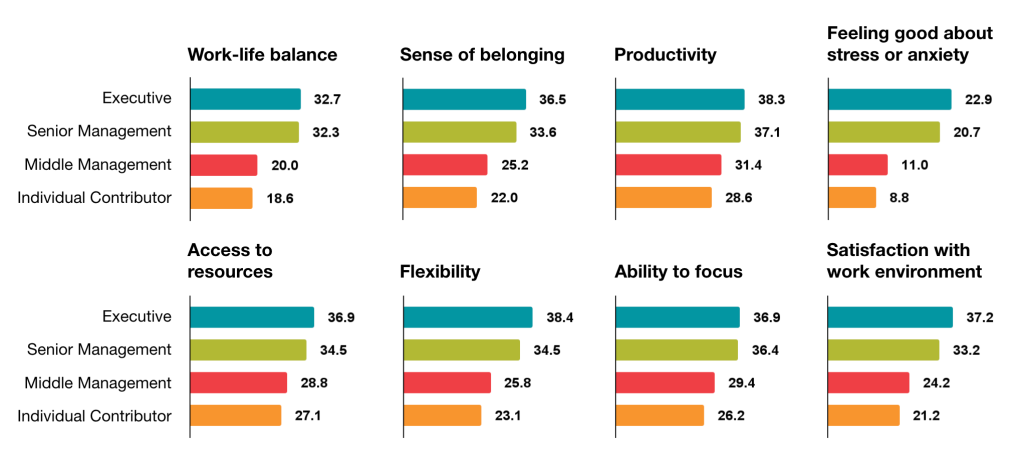
The end of business as usual: the power of empathetic management in an age of uncertainty
A playbook for leaders looking to create clarity, inspire trust and support diverse perspectives
Posted October 5, 2021 by Sheela Subramanian
This blog was co-written by Sheela Subramanian, Vice President, Future Forum, and Tina Gilbert, Managing Director, Management Leadership for Tomorrow (MLT).
MLT is a founding partner of Future Forum. For more information, please read more about the partnership.
As new variants extend COVID protocols into 2022 and beyond, experts are predicting the pandemic is just a first act in an era of continued disruption and discontinuity. “No one knows anything for sure about what’s coming,” writes the futurist Alex Steffen. “Being ready when the big shifts come … involves being able to work successfully in unprecedented situations.”
Many of today’s business leaders learned the ropes and rose through the ranks during a time of relative predictability. COVID required all of us to adapt to rapidly changing circumstances at a pace few would have thought possible. But looking ahead to an era of overlapping crises—from an ongoing pandemic to political and economic instability to the fight for social justice to more frequent climate-related disasters—that speed of change is likely the new normal.
This level of discontinuity is causing a major challenge for managers: how do you lead diverse and increasingly distributed teams through uncertainty and disruption?
This playbook is for leaders who want to learn more about:
Empathy in leadership is more powerful than ever
Throughout this era of uncertainty, at least one workforce reality hasn’t changed: the critical role managers play in your business, and in your employees’ lives. Fifty-six percent of employees rate “my employer” as a very or extremely credible source of workplace information – and 77% said their employer is the institution they trust the most, above government, NGOs and the media. But high trust comes with high stakes: 75% of workers cite a bad manager as the number one reason for leaving a job.
The new challenges inherent in managing distributed teams raises the stakes even further. By the end of 2021, experts predict the number of remote workers will be three times pre-pandemic levels. Leaders of remote and hybrid teams must leave behind outdated systems of management, which have rewarded presenteeism and tenure over agility and flexibility and command-and-control leadership over collaboration, knowledge-sharing and employee engagement. The age of the manager as a gatekeeper is done; today’s successful leaders are empathetic coaches who focus on creating environments of connection and trust.
The problem: “We’re not trained for this.”
Managers are buckling under the weight of outdated management expectations that don’t apply to completing complex, interdisciplinary work — let alone building shared purpose among a diverse and distributed workforce looking for connection during unstable times.
According to new data from the Future Forum Pulse, middle managers report considerably lower employee experience scores than executives right now. Middle managers scored lower than executives on all employee experience measures, including nearly two times lower for both “sense of belonging” and “work-related stress.”
And the negative experience is trickling down to their teams. Individual contributors have the lowest employee experience scores out of all employee groups, and the lower an employee is in the organizational hierarchy, the worse their employee experience scores.
Employee experience, by job tier

The context: empathetic, inclusive management makes teams more resilient
For organizations to build the kind of welcoming and inclusive culture that can succeed through ambiguity and uncertainty, managers need to lead with trust, empathy and transparency. But too many managers aren’t yet equipped to thrive in this new reality: alumni data from Management Leadership for Tomorrow shows 35% of survey respondents have found it more difficult to get information about key organizational priorities and 39% have found it harder to receive career guidance and advice since moving to a distributed work model.
“Innovation, creativity and teamwork flourish when all employees are seen, heard and encouraged to bring their different backgrounds and perspectives to the table,” says Tina Gilbert, managing director of Management Leadership for Tomorrow. “And as the pandemic has shown, while discontinuity is difficult for everyone, underrepresented communities are disproportionately affected, with their lived experiences being marginalized.”
New data from the Future Forum pulse shows that in the U.S., white male employees are still scoring the highest overall across many key well-being indicators.
Well-being indicators, by race
Percentage of respondents who say “I value the relationship I have with my co-workers”

Inclusive management is not just a nice-to-have. It is now a key skill for any successful manager. “Leaders should work to create equitable processes to enable all to participate,” says Gilbert. “Managers should stay tuned-in to the unique pressures and circumstances affecting each individual team member and then create the spaces and opportunities for team members to thrive.”
The solution: creating clarity, earning trust, and embracing diverse perspectives
Executives need to work with managers to meet the business challenges posed by disruption and to create inclusive, connected cultures for diverse and distributed teams. Early action should focus on three interlocking priority areas: creating clarity, earning trust and embracing diverse perspectives.
The purpose of managers is to create clarity.
Leaders must synthesize and share information and provide the context their teams need to remain agile and maintain momentum in the face of rapid change. They also must show their team how each employee’s contribution ladders up to organizational goals. As employees have navigated the disruptions of the past year, they’ve been making their best educated guesses about everything from pandemic safety to KPIs. Going forward, successful managers must realize that clarity is built on transparency.
Four tactics to create clarity
- Establish team norms and agreements: Discuss, decide on and adhere to norms that will govern your team’s daily work. Check out some frameworks from our colleagues here at Slack and the folks at Murmur to get started. Adopting core hours will ensure adequate time for deep, focused work. Setting clear expectations for deadlines and responsiveness will relieve the pressure to be “on” 24/7. And deciding on which tools to use for which tasks will free up more time for genuine creativity.
- Drive alignment to goals: It is on executives and managers to set clear goals, to communicate how these goals support the organization’s overall purpose and to ensure progress is shared transparently to build trust—and momentum!
- Market your priorities: During uncertain times, defining and communicating your organization’s priorities becomes even more important. Employees need to know not just what they should be focused on, but also what they should not focus on, and why. Making it safe to say “no” to less important work increases the odds of success on what really matters—and prevents burnout and attrition.
- Provide role and reporting clarity: The last thing employees need is more uncertainty. Executives must ensure that their managers know and communicate who’s responsible for what and that teams are using the right tools and platforms to share and find necessary information asynchronously and efficiently.
The day-to-day focus of managers is to inspire trust.
Trust is built by investing in people’s well-being and career development. Building an environment of psychological safety is a critical first step; the ability of people to question assumptions and share ideas without fear of repercussions.
Four tactics to inspire trust
- Ensure transparency by being up front about what is known and unknown: Employee expectations around the frequency and channels of communication are changing—fast! “When companies don’t keep up with new communication norms, the conversation doesn’t stop—it just happens without you,” writes Amanda Atkins, former head of Internal Communications for Slack.
Executives should stop pressuring managers to always have the answers, and start encouraging them to build trust through transparency, vulnerability and being up-front about knowns and unknowns.
- Issue a personal user manual: Many teams are adopting the practice of creating a “‘Marauders Map’ for your personality.” These personal user manuals explain communication style, flaws, pet peeves and other key information to help team members see their co-workers as people—which sets the groundwork for extending each other compassion and empathy during tense times. Check out this guide for making personal user manuals from Atlassian to get started.
- Create psychological safety by starting at the top: Research shows that psychological safety starts at the top, with executives developing and modeling the leadership behaviors they want to see across the organization. As a first step, encourage your managers to facilitate a team discussion specifically about the mechanics and challenges of remote work, or other byproducts of discontinuity. Managers should lead the way by sharing their own constraints and challenges first, modeling vulnerability.
- Move from a performance culture to a learning culture: Psychological safety is the foundation of a “learning culture,” in which “people have the humility to know what they don’t know and the curiosity to rethink the way they’ve always done things,” writes organizational psychologist Adam Grant. Learning cultures have long been shown to foster innovation and creative problem solving, while performance cultures can prioritize short-term results and time-tested processes over long-term growth and worthwhile risks.
The golden key for managers (and the hardest part) is to unlock potential and support teams with diverse perspectives.
It’s no secret that diverse teams create more friction—but that friction can be a source of revitalizing energy. “Diverse groups tend to engage in more rigorous decision-making, more consideration of different perspectives, which lead them to decisions that are more objective; they’re less likely to make certain mistakes,” says Evan Apfelbaum, a behavioral researcher at Boston University. A BCG study found that companies with above-average diversity in senior leadership are more innovative and have higher earning margins than companies with less diversity at the top.
Four tactics for supporting diverse perspectives
- Measure outcomes, not inputs: Measuring team members’ performance based on inputs like 24×7 responsiveness and presenteeism primes employees for burnout—and the burden of meeting those outdated and often culturally biased expectations is heavier for members of underrepresented and historically marginalized groups. Instead, encourage your managers to set achievable and relevant goals for their teams and to measure performance based on outcomes.
- Stage regular career growth conversations to leverage employee “Total Motivation”: Your best managers instinctively understand that the most valuable employees are not motivated by money alone. Managers need to understand the motivations—including career goals and aspirations—of their team members and assign roles and responsibilities to fit. Lindsay McGregor and Neel Doshi, authors of Primed to Perform, describe this as “Total Motivation” (ToMo).
Discontinuity adds a layer of complexity and even greater need for empathy from managers: how many of us aren’t re-examining our motivations after the uncertainty and stress of the past year? As an executive, it’s your responsibility to teach managers to stage ongoing and regular career-oriented conversations with direct reports and think about how to best leverage their passions and interests.
- Acknowledge real-world challenges (and be okay with not being the expert): In a bygone era, managers strove for strict separation between business matters and social issues. But that mindset is a luxury rooted in privilege. When leading diverse teams, managers must be willing and able to maintain at least a working literacy with current events and to facilitate honest conversations about forces of social upheaval among teams.
- Build equity into processes and policies: Times of rapid change require ongoing interrogation of the processes and policies across your organization. Consider: are they fair and equitable? Have they been conceived for and by employees from diverse perspectives? Do they serve your goals for flexibility? Do they foster the success of underrepresented talent? Designing with underserved groups in mind often results in improvements that end up benefiting all. This phenomenon is known as the Curb-cut Effect, a term coined by Angela Glover Blackwell, founder of PolicyLink. As Blackwell writes, “solutions designed to serve the most vulnerable lead to large-scale positive impacts.”
As Amy C. Edmondson and Mark Mortensen write in Harvard Business Review, psychological safety is a “critical driver of high-quality decision making, healthy group dynamics and interpersonal relationships, greater innovation and more effective execution in organizations.”
During uncertain times, refocusing on inclusion and equitable processes leads to increased psychological safety—and resilience. Companies that can attract a diverse range of top performers, align them with organizational goals and enable their agility will win. Managers that lead with empathy will unlock their team’s potential and win big!

